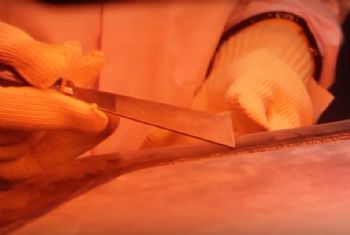
A revolutionary new technology developed by the National Composites Centre (NCC) and Oxford Brookes University means composite structures can now be separated (or disbonded) quickly and cheaply using a simple heat source. By making it easy to work with, repair and disassemble composite parts, this world-leading research could have a transformational impact on the design, use and end-of life recycling of wide range of products, including cars, aircraft and wind turbines.
Researchers at Oxford Brookes University demonstrated that by adding low-cost additives to off-the-shelf structural adhesives, composite parts could be separated in as little as six seconds by raising the temperature of the joint to approximately 160°C. The National Composites Centre has now proved that the new approach works at an industrial scale as part of the Technology Pull-Through Programme, designed to transition new ideas from the lab to the marketplace.
Small quantities of expandable graphite (widely used for fire protection) or thermal expandable microspheres are added to adhesives routinely used to bond composite parts. The additives have minimal impact on the performance of components in normal operation, but when heated to the required temperature exert a force causing components to ‘pop apart’. This means, in the near future, composite components may be easily repositioned and reused during manufacturing – reducing waste, repaired in operation and recycled more efficiently at the end of their working life.
“This is a really exciting development, especially with sustainability being an increasingly significant challenge for the industry,” said Lucy Eggleston, Research Engineer at the NCC. “Historically, when a part is damaged or reaches the end of its life, it would be classed as waste and discarded. With this technology, we can take these structures apart to be repaired, reconfigured, or used in different ways. This could increase available end of life strategies for components, ultimately reducing their impact on the environment.”
The automotive sector, for example, is looking to increase its use of composites and bonded (glued) parts in order to reduce vehicle weight. Vehicles also have to be 85% recyclable to comply with end-of-life directives. The new technology would allow mechanics to swap damaged parts using a simple heat gun. Recyclers could put whole cars through low-temperature ovens and watch them dissemble themselves in seconds.
Other sectors that could benefit include aerospace and renewables. 600 commercial aircraft are scrapped in a typical year[1], with more modern versions making extensive use of expensive carbon fibre – up to 50% of the weight of the vehicle in some instances[2]. Despite the value of this material, the limitations of current recycling technologies make it uneconomic to recover. The same is true for wind turbine blades, which are typically made up of glass-fibre skins with balsawood cores and metal or carbon-fibre spars. It is estimated that decommissioning the UK’s offshore turbine farms, when they reach the end of their operational life, could be as high as c. £3.64bn[3], with up to 10,000 tonnes of turbine blades to be disposed of every year by 2035[4].
Professor James Broughton, Head of Joining Technology Research Centre at Oxford Brookes University, added: “We’ve been looking at ways to disbond structural adhesives for about 10 years, and working with the NCC through the Technology Pull-Through programme has enabled us to prove the technology readiness of our research. We can now work with industry to fully optimise the technology for specific applications and tailor it for them as required.”